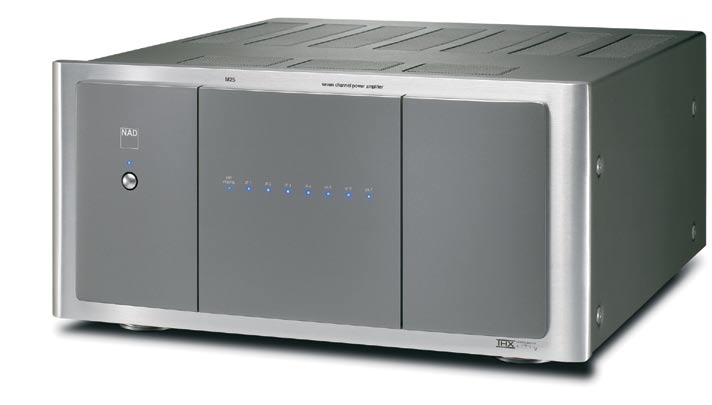
NAD A/V components enjoy a reputation for putting sound quality first, and for delivering excellent value for money. Even so, performance-minded enthusiasts have long wondered what would happen if NAD pulled out all the stops to build no-holds-barred, top-tier components. Now with the release of NAD’s Masters Series M15 multichannel controller and M25 7-channel power amplifier, the wondering is over. Both units are THX Ultra-2 certified and priced at $2999 each.
What first struck me were the exquisite styling and finish of the M15 and M25. NAD burned plenty of midnight oil to refine the design of its Masters Series components, and their beauty carries through on the inside. As you would expect, the M-models are chockfull of high-quality parts and exhibit the careful interior layout and workmanship typical of fine audio components. By design, the Masters Series components look simple, inviting, and easy to use. DaVinci was right: “Simplicity is the ultimate sophistication.”

Initial setup was a snap thanks to well-crafted manuals provided with both components and to the M15’s intuitive remote control. The hardest part, really, was schlepping the humongous M25—all 96.3 pounds worth—out of its shipping carton and into the TPV equipment rack.
Video performance was excellent. I could discern no difference between component and HDMI video signals routed through the M15 versus those run straight from source components to TPV’s reference display.
The M15/M25 pair pushes the sonic performance envelope further than previous NAD components ever could. On one hand, traditional elements of the NAD “house sound” are present and accounted for: smooth highs; natural, open-sounding midrange; and robust, well-defined bass. On the other hand, the M15/M25 take resolution, textural finesse, and soundstaging to a whole new level. In short, the M-models preserved everything that made NAD good in the first place, while ratcheting up performance on the myriad fine points that spell the difference between good components and great ones.

In action-oriented film sequences, such as the XF-1l spy plane crash scene from The Aviator, the M15 and M25 carried themselves with equal parts poise and dynamic swagger. They caught the violent screech of the XF-11’s wing peeling the top off a Beverly Hills residence like some demonic can opener, but then shifted gears to capture Hughes’s post-crash urgency as he gasps, “I’m Howard Hughes, the aviator…” Some components handle big moments well while others are good at finesse, but few can do both things at once at such a high level. But more importantly, the M15/M25 pair offers natural, unforced clarity on dialog. Listen to the golf course banter between Hughes and Katharine Hepburn (Cate Blanchett) in The Aviator, and you will hear why Blanchett won an Academy Award for her performance (her Hepburn accent is spot on).
On CDs and high-resolution music material, the M15 and M25 proved delightful. They did a fine job of capturing small details and textures, faithfully conveying the sense of air and space surrounding performers. Like many high-end audio components, the NAD pair shows a certain chameleon- like quality, reflecting the sonic characteristics of whatever material they are fed. And when fed well-made recordings, the NAD pair sounds jaw-droppingly great.
I savored Steve Strauss’s performance of the Springsteen tune “Youngstown” from Just Like Love, an SACD released under the German audiophile label Stockfisch. Strauss’s dark, rough-hewn voice appeared front and center, reinforced by his light, supple guitar work. In the near background, a crack team of sidemen including guitarist Chris Jones, fretless bassist Hans-Jörg Maucksch, and percussionist Beo Brockhausen helped flesh out the sound. But what really made the track jump was eerie low percussion whose ominous thumping and clanking was reminiscent of heavy machinery from a steel mill. I was deeply impressed by the way the NAD gear at once delineated and yet wove together these diverse musical elements within a holographic, three-dimensional soundstage. Multichannel audio just doesn’t get much better than this.






















